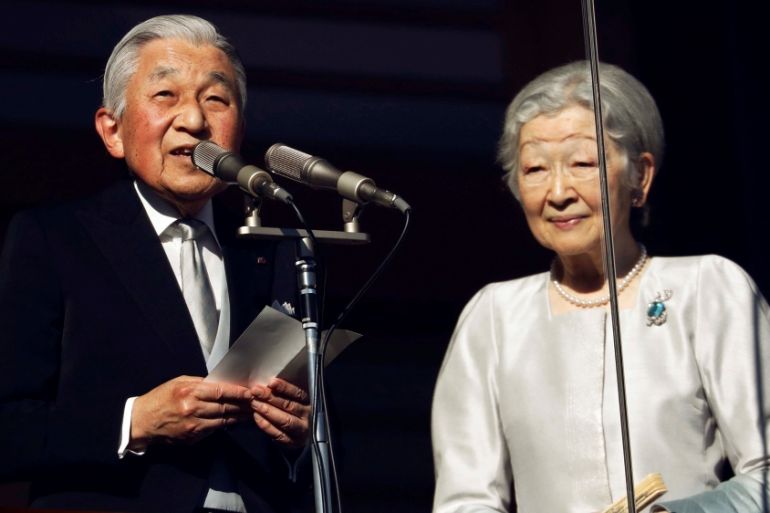Japan Emperor Akihito greets thousands in last New Year’s address
Tens of thousands of well-wishers gather at Imperial Palace to see emperor’s final New Year’s greeting in his reign.

Japan‘s Emperor Akihito has delivered his final New Year’s greeting before his abdication at the end of April, telling tens of thousands of flag-waving well-wishers that he was praying for peace.
The Imperial Palace said more then 72,000 people gathered at the royal residence in the capital, Tokyo, on Wednesday morning alone, with many more still arriving for a final chance to see the 85-year-old royal extending his traditional brief address this time every year.
Akihito will become the first Japanese monarch to abdicate in around two centuries when he steps down from the throne on April 30, ending his three-decade reign. His eldest son, Crown Prince Naruhito, is set to ascend the Chrysanthemum Throne a day later, continuing the rule of what is said to be the world’s oldest imperial family.
“I’m sincerely glad to celebrate the new year together with you under the clear sky,” Akihito told thousands of people, many shouting “Banzai” or “long live”.
“I pray for the peace and happiness of the people of our country and the world,” the soft-spoken Akihito added, flanked by Empress Michiko and other family members.
The emperor was expected to appear five times on Wednesday to address as many well-wishers as possible.
Some in the morning crowd yelled “Thank you very much” as the emperor waved from the balcony, while others sang the national anthem. One woman in the front row shed tears as she looked up at the balcony.
![Well-wishers wave Japanese national flags during the appearance of Emperor Akihito at Tokyo's Imperial Palace [Issei Kato/Reuters]](/wp-content/uploads/2019/01/1cce592247f040fda6fc52606eec4733_18.jpeg)
Akihito shocked the nation in 2016 when he signalled his desire to take a back seat, citing his age and health problems.
The status of the emperor is sensitive in Japan given its 20th-century history of war waged in the name of Akihito’s father Hirohito, who died in 1989.
Akihito has keenly embraced the more modern role as a symbol of the state, imposed after World War II ended. Previous emperors, including Hirohito, had been treated as semi-divine.
In a rare emotional address to mark his 85th birthday last month, Akihito pointed to the “countless lives” lost in the war.
“It gives me deep comfort that the Heisei Era (his reign) is coming to an end, free of war in Japan,” he said.
Akihito has used his speeches and travels to express his strong pacifist views, which are sharply at odds with the aggressive expansionism Japan pursued under his father’s rule.
Akihito has also worked to bring the royal household closer to the people and frequently visited the disadvantaged and families hit by natural disasters.
The origins of Japan’s monarchy are ancient and legend says that it is an unbroken line going back some 2,600 years.
It is deeply ingrained in the nation’s native Shinto religion and it comes with numerous ritual duties.
![The emperor along with Empress Michiko, Crown Prince Naruhito and Crown Princess Masako [Issei Kato/Reuters]](/wp-content/uploads/2019/01/de9b52f070e74cbb8f26b9828df5bc6e_18.jpeg)